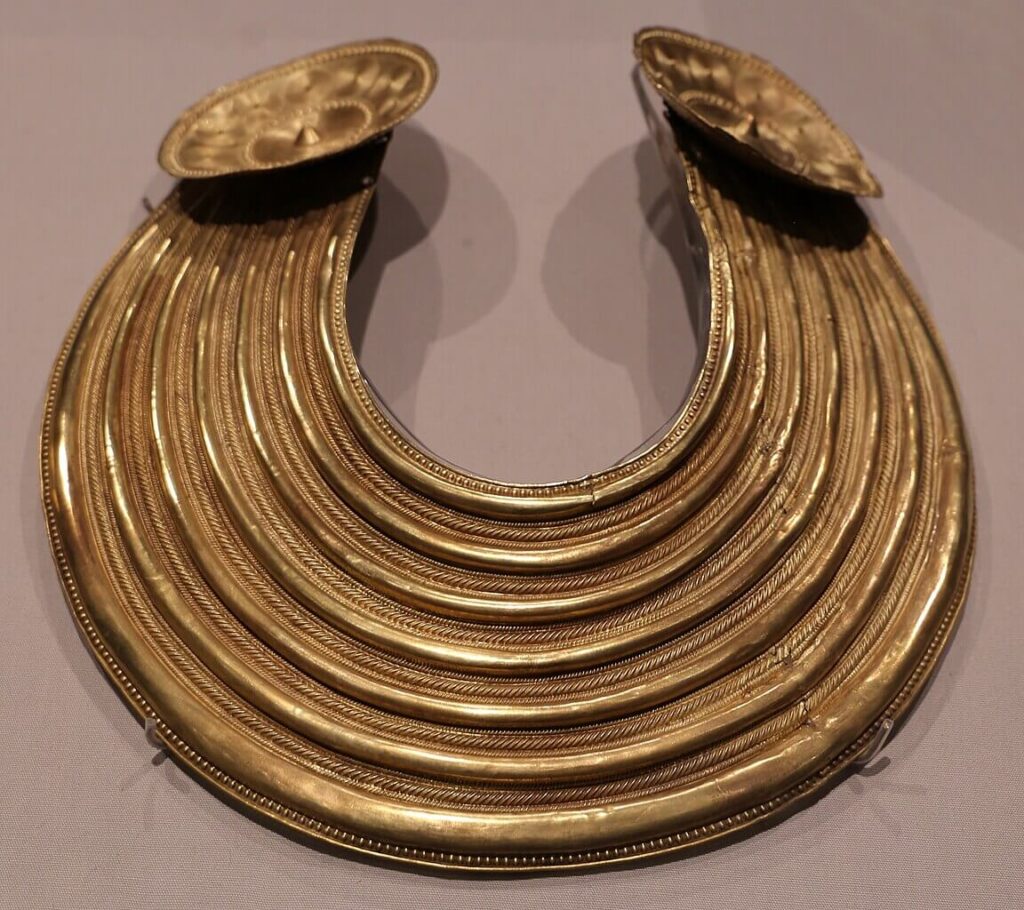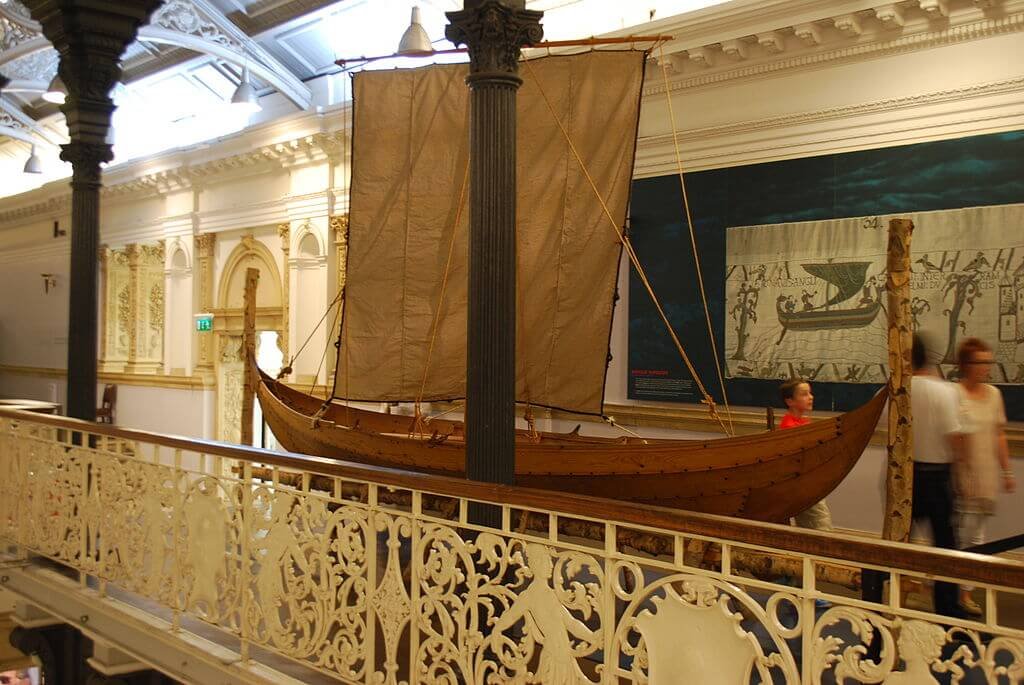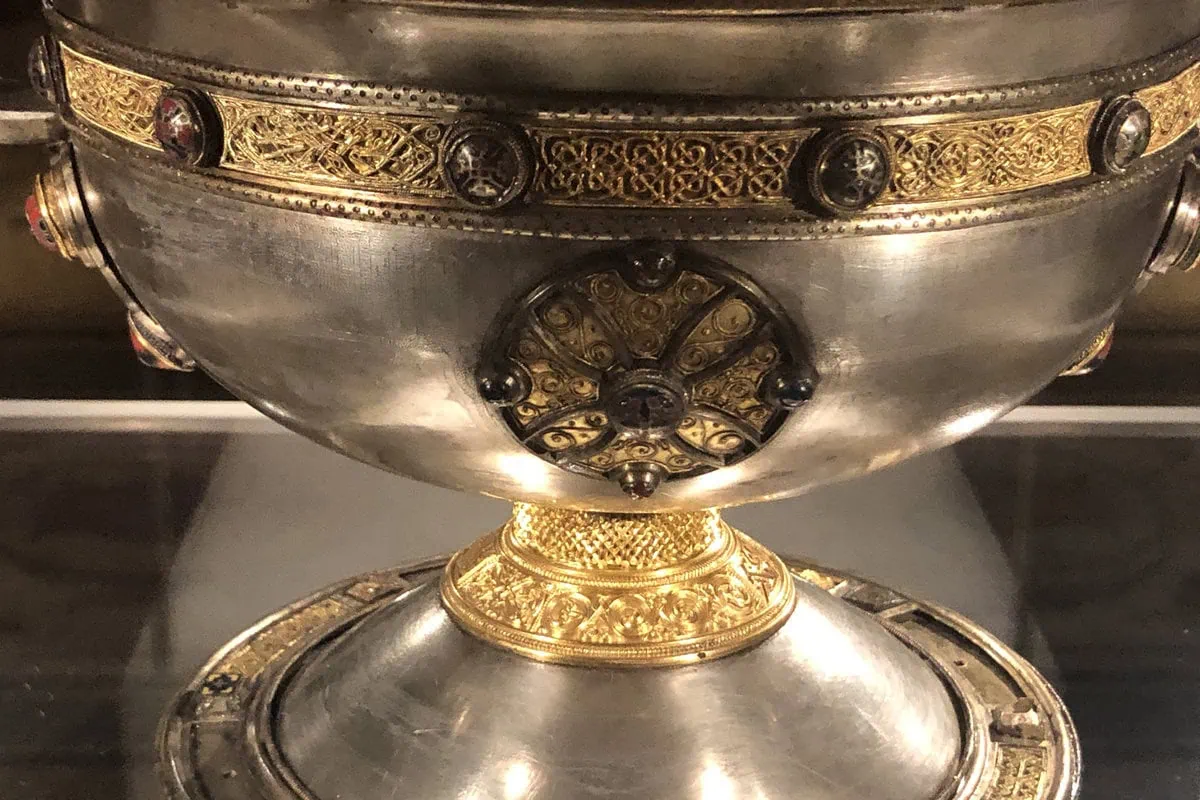Cover image: A close-up of the Ardagh Chalice, 8th century CE. Reerasta, Co. Limerick, Ireland. The National Museum of Ireland – Archaeology. Photo by A Scholarly Skater.
If you read my recent post about seeing the Book of Kells in person, you may think I’ve already told you about the most exciting part of my Ireland adventure. Indeed, I was thrilled by my Book of Kells experience, but one other attraction was at least as memorable. At the National Museum of Ireland’s archaeology museum in Dublin, I saw a plethora of spectacular objects from prehistory to the Middle Ages, including almost all of medieval Ireland’s great artistic treasures in precious metals. It truly is a must-visit destination for lovers of medieval art and a dream come true for me.
It’s more than just a repository for beautiful things, however. Through a combination of objects and educational text panels, the museum illuminates this country’s eventful early history and the different groups – early Irish, Celts, Vikings, and Anglo-Normans – who shaped it. I loved the museum so much I went back and visited it a second time a few days later.
Hey everybody! I’m just reminding you that everything in a museum is subject to change – exhibitions, artworks on display, opening times, and prices. I can only tell you what the museum was like the last time I was there, which might not stay the same. It’s not only that exhibitions change and prices increase; I’ve revisited museums and found their fundamental personalities to be really different from my last visit (or that half their galleries are closed for renovation). I know how sad a disappointing museum visit can be, so I’m reminding you to check everything out on the museum’s website ahead of time.
Prehistoric gold… and bodies

This museum has tons to see – much more than its gallery map would suggest. The ground floor contains objects from prehistory – both the original inhabitants of the island and their Celtic successors – through the great age of Irish monasticism in the early Middle Ages. Naturally, the prehistoric selection includes some items that are historically significant but not super aesthetic, like spear heads, discarded weapons, and fragments of everyday objects. But some of this non-art stuff is really cool, like an ancient, wooden dugout canoe of unbelievable length.
There’s also a highly unusual exhibition here, and that’s the bog bodies – a group of human remains found in bogs throughout the island after being human sacrifices thousands of years ago. (As you’ll quickly learn in this museum, the ancient Irish had a habit of putting things in bogs.) Now this is pretty gnarly in more ways than one, and I was not a fan. Fortunately, there’s a tomb-like curved wall around each of the five or six bodies, so you can easily pass through the room without seeing them if you wish. If you do want to look, I would urge you to remember that these were actually people, so please approach them with some respect.

Fortunately, prehistoric Ireland was not entirely morbid; there’s also an astonishing amount of huge, intricately-decorated gold jewelry. Most of it is located in the very center of the museum, and it’s well worth spending time there. The main prestige items are lunulae (singular: lunula; paper-thin gold collars with incised decoration), thicker and heavier gold collars with intricate, rope-like decoration, torcs (often-twisted gold necklaces characteristic of the Celts), and dress fasteners (massive gold objects that look like telephone receivers but apparently could hold your dress closed). There are also bracelets, shockingly large beads and earrings, and other gold items from various hoards.
The Age of Saints and Scholars

There’s even more gold in the Medieval Treasury, which was the museum’s real highlight for me. This long gallery displays such celebrated medieval metal objects as the Tara Brooch, Cross of Cong (my personal favorite; my photo doesn’t do it justice at all), Ardagh and Derrynaflan chalices, and Shrine of Saint Patrick’s Bell alongside lesser-known but still amazing brooches, croziers (curved Bishop’s staffs, but they look wonderfully like horse heads from certain angles), and various ecclesiastical items. Most of the objects I was most excited about seeing in all of Ireland are in this room, and they definitely met my expectations. Made of shining gold and silver, they’re decorated with panels of interlace, animal and human heads and figures, glass, enamel, semi-precious stone inlays, and more. They’re exuberant but also elegant at the same time. Everywhere you look, there’s a bit of detail you hadn’t noticed before. I suspect you could visit these objects every day and still make new discoveries. If this early medieval Irish metalworking tradition is new to you, lean about it in this post.

Additionally, the ground floor has some galleries dedicated to what the Irish call the age of saints and scholars, aka the Irish monastic tradition in the early Middle Ages. This is the context in which most of the objects in the treasury gallery were made. There’s a gallery about the monastery at Glendalough (more on this site in a future post) and a special exhibition about the life of Saint Columcille (Columba). He is one of the major Irish saints, probably second after Saint Patrick, and he’s famous for establishing monasteries not only in Ireland but also elsewhere in Europe. His exhibition included a pair of impressive shrines for books associated with him. (Books owned by saints were sometimes treated as relics in medieval Ireland and were even carried into battle. This shows an attitude towards books that I can definitely get behind!) These book shrines are decorated with interlace, jewels, and figurative imagery in relief.

Speaking of books, there’s also an exhibition about the Faddan More psalter, an early medieval manuscript that was found in a bog in 2006! There isn’t much to see here, since the psalter (book of psalms) is in pretty rough shape, must be kept under low lights, and is still being studied. However, it was cool to be in the presence of a few pages from this unlikely survival, and the wall texts do a good job of explaining the find’s significance.
Viking and Norman Ireland

The museum’s first floor (what we in the U.S. would call the second floor) has an exhibition dedicated to Viking Ireland. The material here is not as visually impressive as that downstairs, but the ideas are really interesting. In particular, I enjoyed a display about the Battle of Clontarf (1014 CE) between Viking and Irish forces. It explained how little archaeologists actually know about this famous event. The Vikings had an important effect of Irish art, culture, and history. They even established major cities like Dublin itself. There was also an interesting section about life under Norman (English) rule starting in the 12th century. I enjoyed the audio display that let you listen to Irish Gaelic, Norman French, and Old English as spoken in this period.
A separate exhibit focuses on later medieval society, commerce, and the church more broadly, with objects from up until about 1650. I especially liked all the architectural fragments and other finds from medieval churches. This section also includes some later precious metalwork objects, like the Shrine of Saint Patrick’s Tooth.
Advice for visiting

If you have any interest at all in medieval art, Irish history, or even just shiny beautiful things, don’t miss the National Museum of Ireland’s archaeology museum. You’ll definitely want to allow plenty of time for this museum and visit on a day when you’re feeling fresh and energized. There’s lots to see and read. Because it’s an archaeology museum, you’ll definitely want to read copiously in order to fully understand things. An object’s significance isn’t always full apparent just by looking at it. Plus, a lot of this will likely be unfamiliar to those without prior knowledge of prehistoric art or Irish history, so you’ll want to take your time to absorb things at your own pace. All the text panels and labels are bilingual in English and Irish.
The building is really lovely as well, with a great rotunda for an entrance hall. However, it has a lot of classically-inspired decoration, like columns with putti on the bases, that doesn’t really fit with the focus of Irish culture and archaeology. This leads me to believe that the museum had different priorities when this structure was originally built in the 19th century. The museum is located next door to Leinster House, which is where the Irish Parliament meets, but has its own entrance. On the other side of Leinster House is the museum building’s twin housing the National Library.
Practicalities

The National Museum of Ireland – Archaeology is located in Kildare Street in Dublin – not far from Trinity College and the Book of Kells. There’s no admission charge. Donation boxes ask for a €5 donation, which feels more than fair considering the museum’s amazing contents, but the donation and admission are totally separate. There is a nice gift shop with a good selection of books, souvenirs, and Irish products. But there’s no cafe, so eat beforehand. There are plenty of nice pubs within a few blocks of the museum. If you want to take a tour, the best options seem to take place on Saturdays.
The National Museum of Ireland also has three other venues, all with free admission. The Decorative Arts/History and Natural History museums are both located in Dublin, while the Country Life museum is in County Mayo.
If you want to see Irish art from later centuries, you’ll instead want to visit the National Gallery of Ireland. It’s also free and has painting and sculpture from Ireland in addition to art from England, Scotland, and mainland Europe. During my visit, I especially enjoyed an exhibition about 19th-century Irish stained glass and one about Walter Frederick Osborne’s elegant portrait of Mary and Margaret Guinness.


